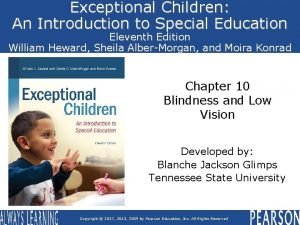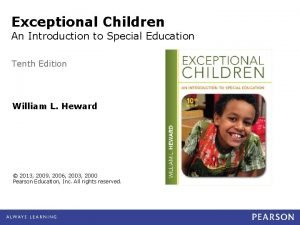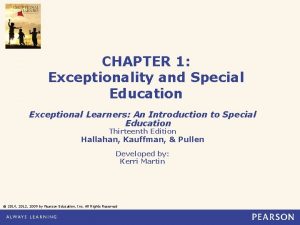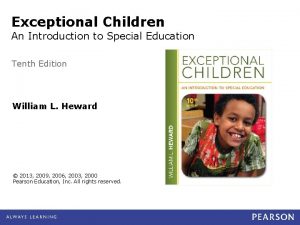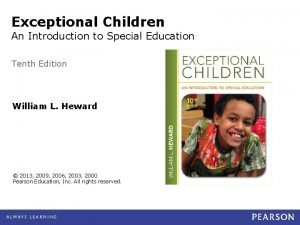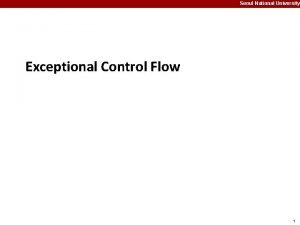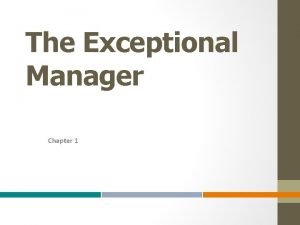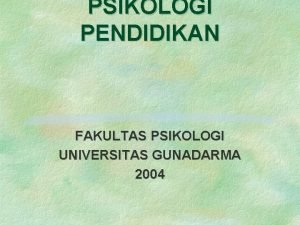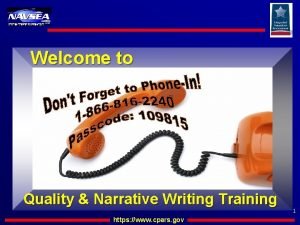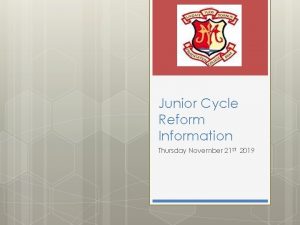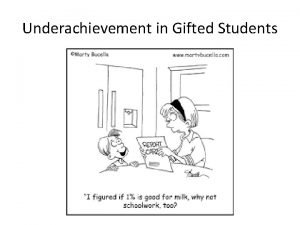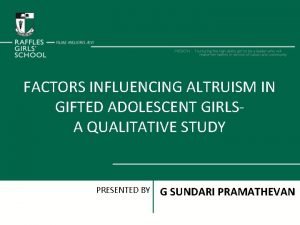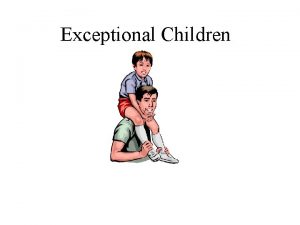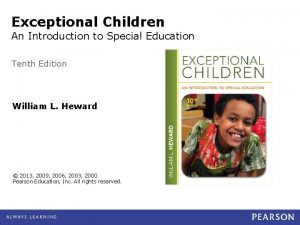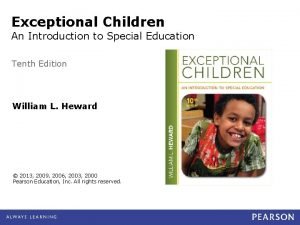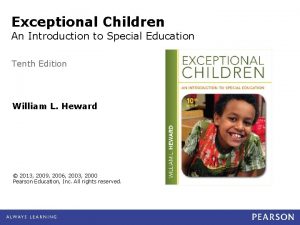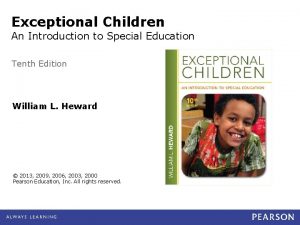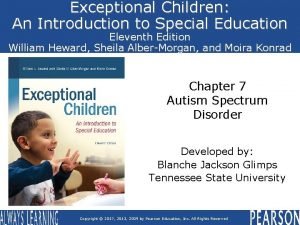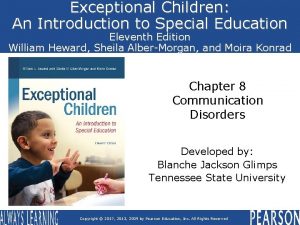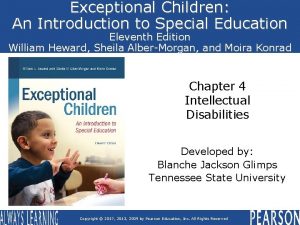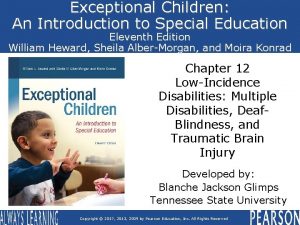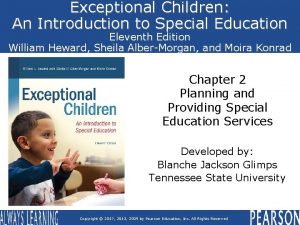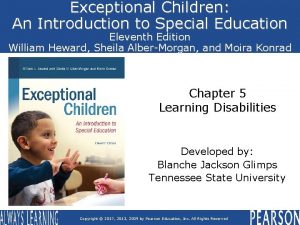Exceptional Children An Introduction to Special Education Tenth





















- Slides: 21

Exceptional Children An Introduction to Special Education Tenth Edition William L. Heward © 2013, 2009, 2006, 2003, 2000 Pearson Education, Inc. All rights reserved.

Chapter 5 Learning Disabilities

Focus Questions q. Why has the concept of learning disabilities proven so difficult to define? q. What characteristic encompasses all students with learning disabilities? q. What factors might account for the huge increase in the prevalence of students identified with learning disabilities since the category was officially recognized in the mid-1970 s? q. Are the achievement deficits of most students diagnosed with learning disabilities the result of neurological impairment or poor instruction? Heward Exceptional Children, 10 e © 2013 Pearson Education, Inc. All rights reserved. 5 -2

Focus Questions (cont. ) q. What can a student’s responsiveness to evidence-based instruction reveal about the need and focus of special education? q. How can academic tool skills and learning strategies relate to each other? q. What skills are most important to the success of an elementary-age student with learning disabilities in the general education classroom? for a secondary student? Heward Exceptional Children, 10 e © 2013 Pearson Education, Inc. All rights reserved. 5 -3

IDEA Definition of Specific Learning Disability (LD) A disorder in one or more of the basic psychological processes involved in understanding or using language May manifest itself in an imperfect ability to: • Listen, think, speak, read, write, spell, or do mathematical calculations Includes such conditions as perceptual disabilities, brain injury, minimal brain dysfunction, dyslexia, and developmental aphasia Does not include learning problems that are the result of other disabilities or environmental, cultural, or economic disadvantage Heward Exceptional Children, 10 e © 2013 Pearson Education, Inc. All rights reserved. 5 -4

Operationalizing the Definition Most states require three criteria be met to receive services: Discrepancy between intelligence and achievement • An “unexpected” difference between general ability and achievement Exclusion criterion • The student’s difficulties are not the result of another known condition that can cause learning problems A need for special education services • The student shows specific and severe learning problems despite standard educational efforts Heward Exceptional Children, 10 e © 2013 Pearson Education, Inc. All rights reserved. 5 -5

Responsiveness to Intervention A local education agency may use a process that determines if the child responds to scientific, research-based intervention as a part of the evaluation procedures. The responsiveness to intervention approach shifts the identification of learning disabilities from a “waitto-fail” model to one of early identification and prevention. Heward Exceptional Children, 10 e © 2013 Pearson Education, Inc. All rights reserved. 5 -6

The NJCLD and the Definition of LD The NJCLD believes the federal definition of LD contains several weaknesses: • • • Exclusion of adults • Learning disabilities can occur across the life span Reference to “basic psychological processes” • This is a curricular issue concerning how to teach and not a definitional one Inclusion of spelling as a learning disability • Spelling can be subsumed under “written expression” Inclusion of obsolete terms • Includes terms that are difficult to define Wording of the exclusion clause • Suggests that learning disabilities cannot occur with other disabilities Heward Exceptional Children, 10 e © 2013 Pearson Education, Inc. All rights reserved. 5 -7

The NJCLD Definition of LD q. A general term that refers to a group of disorders manifested by significant difficulties in the acquisition and use of listening, speaking, reading, writing, reasoning, or mathematical abilities q. These disorders are intrinsic to the individual and presumed to be due to central nervous system dysfunction and may appear across the life span q. Problems with self-regulatory behaviors, social perception, and social interaction may coexist but do not themselves constitute a learning disability q. Although learning disabilities may occur with other handicapping conditions or with extrinsic influences, they are not the result of those influences Heward Exceptional Children, 10 e © 2013 Pearson Education, Inc. All rights reserved. 5 -8

Characteristics Students with LD experience one or more of the following difficulties: • Reading problems - 80% of all children identified • Deficits in written language - Perform lower than their agematched peers without disabilities across most written expression tasks • Underachievement in math – More than 50% have math IEP goals • Poor social skills - 75% have social skills deficits • Attention deficits and hyperactivity • Behavioral problems-Higher than usual incidence of behavior problems • Low rates of self-esteem/self-efficacy-lower levels of selfefficacy, mood, effort, and hope Heward Exceptional Children, 10 e © 2013 Pearson Education, Inc. All rights reserved. 5 -9

Characteristics The Defining Characteristic • Specific and significant achievement deficits in the presence of adequate overall intelligence • The performance gap becomes especially noticeable and handicapping in the middle and secondary grades • The difficulties experienced by children with learning disabilities, especially for those who cannot read at grade level, are substantial and pervasive and usually last across the life span Heward Exceptional Children, 10 e © 2013 Pearson Education, Inc. All rights reserved. 5 -10

Prevalence LD is by far the largest of all special education categories • 42. 3% of all school-age children with disabilities receive services under the LD category and about 4% of the school-age population • Males with LD outnumber females by a ratio of 3: 1 • The rising incidence of children with LD led some scholars to suggest it be considered an epidemic • Some contend that too many low achievers have been improperly diagnosed as LD Heward Exceptional Children, 10 e © 2013 Pearson Education, Inc. All rights reserved. 5 -11

Causes Brain damage or dysfunction – In most cases there is no evidence of brain damage – Neuroimaging research has been reasonably consistent in revealing functional and/or structural differences in the left temporal lobe of the brain of individuals with dyslexia – Educators should refrain from placing too much emphasis on theories linking learning disabilities to brain damage or brain dysfunction Heredity – There is growing evidence that genetics may account for at least some family links with dyslexia Biochemical imbalance – Most professionals give little credence to biochemical imbalance as a significant cause of or treatment for learning disabilities Heward Exceptional Children, 10 e © 2013 Pearson Education, Inc. All rights reserved. 5 -12

Causes (cont. ) Environmental Factors – Impoverished living conditions early in a child’s life and limited exposure to highly effective instruction probably contribute to achievement deficits – The tendency for learning disabilities to run in families suggests a correlation between environmental influences on children’s early development and subsequent achievement in school – Many students’ learning problems can be remediated by direct, intensive, and systematic instruction Heward Exceptional Children, 10 e © 2013 Pearson Education, Inc. All rights reserved. 5 -13

Identification and Assessment Standardized Intelligence and Achievement Tests • Used to measure the discrepancy between achievement and general intellectual ability Curriculum-Based Measurement • Used to measure the growth of student’s proficiency in the core skills that contribute to success in school Direct Daily Measurement • Used for observing and recording a child’s performance on a specific skill each time it is taught Criterion-Referenced Tests • Used to compared a child’s score with a predetermined criterion Heward Exceptional Children, 10 e © 2013 Pearson Education, Inc. All rights reserved. 5 -14

Identifying LD by Assessing Responsiveness to Instruction (RTI) Basic premise of RTI: • Measuring low-achieving student’s response to increasingly intensive, scientifically validated instruction can determine whether the child’s struggles to learn are the result of poor or insufficient instruction or of a disability for which special education is needed Two functions of RTI • Screening/identification and prevention Trustworthiness of RTI depends on • The consistent, rigorous implementation of research-based interventions • Accurate, reliable, easy to use measures for monitoring student progress Heward Exceptional Children, 10 e © 2013 Pearson Education, Inc. All rights reserved. 5 -15

Implementing Responsiveness to Instruction (RTI) Tier I: Primary Intervention in the General Education Classroom • Primary prevention is provided to all students in the form of evidence-based curriculum and instruction in the general education classroom Tier II: Secondary Intervention • Students who are struggling in the general education program receive an intensive fixed-duration trial of smallgroup supplemental tutoring using a research-validated program Tier III: Tertiary Intervention • In most RTI models, Tier 3 is special education Heward Exceptional Children, 10 e © 2013 Pearson Education, Inc. All rights reserved. 5 -16

Benefits and Goals of RTI q. Earlier identification of students using a problem-solving approach instead of a “wait-to-fail” approach q. Reduction in the number of students referred for special q. Reduction in the over-identification of minority students education q. Provision of more instructionally useful data than those provided by traditional methods of assessment and identification q. Increased likelihood that students are exposed to high-quality instruction in the general education classroom by stipulating that schools use evidence-based instructional practices and routinely monitor the progress of all students q. Service to all students with achievement problems, so that only those students who fail to respond to multiple levels of intervention efforts receive the label learning disabled Heward Exceptional Children, 10 e © 2013 Pearson Education, Inc. All rights reserved. 5 -17

Educational Approaches Content enhancements are used to enhance the organization and delivery of curriculum content • Graphic Organizers and Visual Displays • Note-Taking Strategies • Guided Notes • Mnemonics A learning strategy is an individual’s approach to learning tasks • Students use task-specific strategies to guide themselves successfully through a learning task or problem Heward Exceptional Children, 10 e © 2013 Pearson Education, Inc. All rights reserved. 5 -18

Educational Placement Alternatives General education classroom • During the 2008– 2009 school year, 62% of students with LD were educated in general education classrooms. • Research on the academic achievement of students with LD in inclusive classrooms is mixed. Consultant teacher • Provides support to general educators who work directly with students with learning disabilities • Works with several teachers and thus indirectly serve many children • Most consultant teachers have little direct contact with students Heward Exceptional Children, 10 e © 2013 Pearson Education, Inc. All rights reserved. 5 -19

Educational Placement Alternatives Resource room • A resource room is a specially staffed and equipped classroom where students with LD come for one or several periods during the school day to receive individualized instruction • The resource room teacher works closely with general educators to suggest and plan each student’s program • During the 2008 -2009 school year, 28% of students with learning disabilities were served in resource rooms Separate classroom • A special education teacher is responsible for all education programming for 8– 12 students with learning disabilities • During the 2008 -2009 school year, 8% of students with learning disabilities were served in separate classrooms Heward Exceptional Children, 10 e © 2013 Pearson Education, Inc. All rights reserved. 5 -20
 Exceptional children 11th edition
Exceptional children 11th edition Exceptional children an introduction to special education
Exceptional children an introduction to special education Exceptional learners: an introduction to special education
Exceptional learners: an introduction to special education Exceptional children 10th edition
Exceptional children 10th edition Exceptional children 10th edition
Exceptional children 10th edition Human genetics concepts and applications 10th edition
Human genetics concepts and applications 10th edition Exceptional control flow
Exceptional control flow Raleigh and rosse case study
Raleigh and rosse case study Exceptional manager
Exceptional manager Kategori exceptional people
Kategori exceptional people Cpars exceptional rating examples
Cpars exceptional rating examples Maths cba 1 ideas exceptional
Maths cba 1 ideas exceptional Itil event management
Itil event management Twice exceptional celebrities
Twice exceptional celebrities What is cpwa
What is cpwa 2e kids
2e kids Conclusion of exceptional child
Conclusion of exceptional child Conclusion of exceptional child
Conclusion of exceptional child Friends of children with special needs
Friends of children with special needs The tenth man graham greene summary
The tenth man graham greene summary 356 271 rounded to the nearest ten thousand
356 271 rounded to the nearest ten thousand Campbell biology tenth edition
Campbell biology tenth edition
